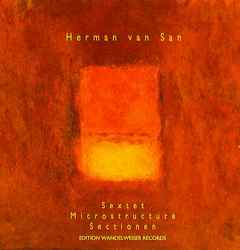EDITION WANDELWEISER RECORDS
> CD catalogue
_____________________________________________________________________
<< >>
Herman Van San (1929 – 1975)
Sextet. Microstructure. Sectionen
| order
reference:
medium: composer: performer: |
EWR 9902 CD Herman Van San Barbara Deleu, Dimitri Baetman, Peter Merckx, Dirk Noyen, Dries Geeraert, Koen Kessels, Götz Hartmann, Rosemarie Keller, Dirk Hegemann, Walter Keller, Wolfram Hertel, Wolfgang Düthorn |
 |
"A few years ago, in the halls of the University of Gent, I stumbled upon a filing cabinet with the name of Herman van San on it.It stimulated my curiosity and i was motivated, over the period of years, to search for information about the works and the person of Herman van San." (Guy Vandromme)Hermann van San was born March 19, 1929 in Mechelen (Belgium), where he died October 26, 1975. He studied music theory and piano with Gabriel Minet in Brussels, Law, Physics and Philosophy at the Université Libre de Bruxelles. On the basis of an analytical positivism and formal mathematical methodology, he aimed at applying the new findings of physics to sound production and the organisation of sound in a composition. The instrumental works of 1953 - 1954 belong to the earliest applications - in a very thorough and strict way - of an analytical-mathematical and symbolic-logical method. Herman van San is still largely unknown. Nevertheless, in terms of music history, he must be considered as being part of a small group of pioneers. His scores from the period 1951 - 1952 are examples of a rigorous application of dodecaphony. Indeed, the level of formalisation is much more rigorous and clearer than any to be found in the works of Schoenberg or Webern. Sextet (1951) for flute, oboe, clarinet, bassoon, horn and piano is a rigorous dodecaphonic composition, divided into seven sections. The stratification of the composition and the complex density of simultaneous time structures immediately attract one`s attention: different meters (with various numbers of beats, but the same duration) are superimposed upon one another. This results in a polymetric progression of segments with varying instrumental coloring. Microstructure (1952) for 3 pianos is an extraordinarily short but strong piece of only 21 seconds, notated on a single page. Polymeter is combined with the procession of an invariant set changing meters which can be found in each part. Rhythmus are limited to a few deinite modules. Silences are a structural element; each tone gets his value, disconnected from the segmentary development. Sectionen (1953 - 1954) for 3 violins and 3 celli is one of the last instrumental works of Herman van San. It is the herald to a new period of composition, which is based exclusively on mathematical models. In this period van San studies the new findings in the physics of sound and their possible applications to music. Various bowing techniques, extensive use of harmonics, pizzicati played with the finger but also with a plectrum, the use of the spatial aspect of sound production by separating the 3 violin - violocello pairs: through all this a highly original sound world is created, distinguishing itself above all through the unfolding of an unusual spectrum of harmonics and intensities. Guy Vandromme |
> top